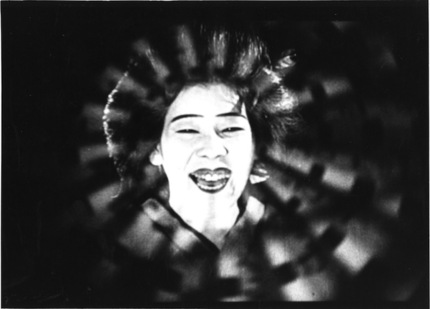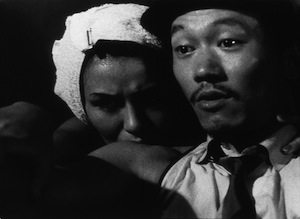NYC Happenings: Two Must-See Films At Japan Society

Regarding the latter, you should know that Kinugasa Teinosuke's silent will be accompanied by a live shamisen-and-percussion performance... but, trust me, even when viewed completely soundlessly the film's imagery carries its own powerful music. Ostensibly a tragic family drama (of sorts), Crossroads should probably be considered a landmark in the institution that is the grotesque in Japanese culture.
On display throughout are the crazed distortions of certain classic woodblock prints as well as the theater-like use of faces that double as masks, whether touchingly innocent or downright inhuman in ugliness. Yet Kinugasa's achievement here doesn't just deserve comparison to other art forms, for it is decidedly cinematic every step of the way with its poetic use of dissolves and multiple exposures, not to mention, say, its lyrical match cuts on swirling hair and smoke. In short, think Murnau at his height, crossed with a sordid, Murphy's Law-flavored storyline out of Pabst or pre-code Hollywood, and with a dash of Tod Browning thrown in for good measure.
To miss out on seeing Crossroads on the big screen, then, is one mistake you'll want to avoid. The only thing one hopes for is that the print is as gloriously aged as the one I've seen, the film's shadows vibrating with scratches and pulses that add to its already almost unbearable expressiveness.
 Though released some forty years later, Inflatable Sex Doll Of The Wastelands shares one obvious aesthetic device with Crossroads: "mindscreen" montages executed with such aggressive subjectivity that they feel more like rapid-fire streams of consciousness than conventional flashbacks or POV sequences. And the term "rapid-fire" is particularly apt as writer-director Yamatoya Atsushi makes no effort to conceal the overt fetishizing of the gun, and his critique of the same, in the realm of sleazoid noir à la Mickey Spillane.
Though released some forty years later, Inflatable Sex Doll Of The Wastelands shares one obvious aesthetic device with Crossroads: "mindscreen" montages executed with such aggressive subjectivity that they feel more like rapid-fire streams of consciousness than conventional flashbacks or POV sequences. And the term "rapid-fire" is particularly apt as writer-director Yamatoya Atsushi makes no effort to conceal the overt fetishizing of the gun, and his critique of the same, in the realm of sleazoid noir à la Mickey Spillane. Both playing with the bleakness of the genre and deconstructing revenge flicks decades before Korean filmmakers did the same thing so famously, Yamatoya made a film that, to invoke a cliché, stimulates the brain as much as the senses. So, yes, you'll see a strikingly neo-realistic use of urban locations along the lines of Allen Baron's Blast of Silence, notice how the jazz score and inspired jagged editing recall Suzuki Seijun (whom Yamatoya worked with), and perhaps consider the degree to which all the casual transgression anticipates Miike in Ichi the Killer mode.
With this last point in mind, please forget anything you've read that describes the film as "sexy"--whatever nudity it serves up is arousing only to the degree that a downmarket American sexploitation film of the same era might be, and weighing overwhelming against even this meager amount of titillation is the anti-sexual nature of the core plot, which after all is about abduction and gang rape.
In fact, the title itself is more than a little misleading: there are only two or three mentions of sex dolls in the entire film and one of these is in the haunting final scene. That is, there's nothing quirky or humorous at work in this theme. Instead, the world Yamatoya constructed is a stylized hell, pure and simple, streaked through with grim flights of imagination. "What a lonely tree," says our hitman protagonist in an early scene. "It looks like it's drinking blood."
Inflatable Sex Doll of the Wastelands and Crossroads are the first two selections in John Zorn's monthly series at Japan Society, The Dark Side Of The Sun. The series runs until February 2015. The full schedule can be seen here.

Do you feel this content is inappropriate or infringes upon your rights? Click here to report it, or see our DMCA policy.






